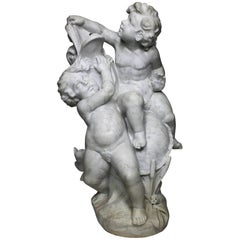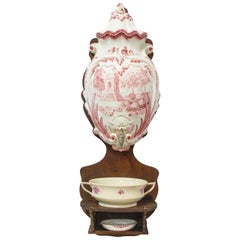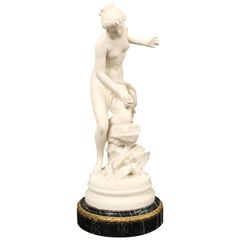Early 1900s Sculptures
5
to
4
5
5
5
5
177
30
18
17
11
7
7
5
4
3
2
2
1
11
45
17
1
13
2
5
1
1
Height
to
Width
to
4
4
4
4
2
5
4
1
1
Style: Louis XV
Period: Early 1900s
Pair French 19th/20th Century Gilt-Bronze Sculptures of The Marly Horses Lamps
Located in Los Angeles, CA
A Fine Pair of French 19th/20th Century Gilt-Bronze Sculptures of "The Marly Horses" (Now turned into lamps) After the original by Guillaume Coustou (French, 1677-1746). The large pair of equestrian bronze sculptures, finished in a gold patina, each depicting rearing horses with their groom, both raised on oval a black slate and Bardiglio marble bases and fitted with modern electrical twin-light brass fittings and cream colored shades. The base on an ebonized wooden platform. Circa: Paris, 1900-1920.
Sculpture & Base Height: 31 1/4 inches (79.8 cm)
Base Width: 21 3/4 inches (55.3 cm)
Base Depth: 12 3/4 inches (32.4 cm)
Height to top of (Adjustable) shade fitting: 48 1/4 inches (122.6 cm)
Shade Height: 15 inches (38.1 cm)
Shade Width: 26 inches (66.1 cm)
Shade Depth: 20 inches (50.8 cm)
The original Marly Horses are two 1743–1745 Carrara marble sculpted groups by Guillaume Coustou. They were commissioned by Louis XV of France for the trough at the entrance to the grounds of his château de Marly. Coustou's last works, they were intended to replace two other sculpted groups, Mercury on Pegasus and Pegasus, Renown of Horses, both by Antoine Coysevox, which had been removed to the Tuileries Gardens in 1719.
Louis XV chose the modellos in 1743 and the full-size sculptures were completed in only two years, being installed at Marly in 1745. They proved highly successful in reproduction, particularly on a smaller scale, and prefigured Théodore Géricault and other Romantic artists' obsession with equestrian subjects. The Marly horses were later also used as the central motif of the monochrome 819-line RTF/ORTF test card which was used on TF1 from 1953 until 1983.
The originals were moved to the place de la Concorde in Paris in 1794 and Louis-Denis Caillouette (1790–1868) restored them in 1840. In 1984 it was concluded that the annual military parades on 14 July were damaging the sculptures and they were replaced by marble copies produced by Michel Bourbon in the studio of a subsidiary of Bouygues. The latter also gained the right to an extra copy, which was placed in Bouygues's social building. The original sculptures were moved to a former courtyard in the Richelieu wing of the Louvre Museum, which was renamed the 'cour Marly' in their honour, whilst Bourbon's two main copies were moved to the originals' first site near the trough at Marly, with work overseen by the architect Serge Macel.
Guillaume Coustou the Elder (29 November 1677, Lyon – 22 February 1746, Paris) was a French sculptor of the Baroque and Louis XIV style. He was a royal sculptor for Louis XIV and Louis XV and became Director of the Royal Academy of Painting and Sculpture in 1735. He is best known for his monumental statues of horses made for the Chateau of Marly, whose replicas now stand in the Place de la Concorde in Paris.
Coustou was a member of a family of famous sculptors; his uncle, Antoine Coysevox, was a royal sculptor; his elder brother, Nicolas Coustou was a sculptor, and his son Guillaume Coustou the Younger also become a noted royal sculptor. Like his older brother, he won the (Prix de Rome) of the Royal Academy which entitled him to study for four years at the French Academy in Rome. However, he refused to accept the discipline of the academy, gave up his studies, set out to make his own career as an artist. He worked for a time in the atelier of the painter Pierre Legros, and eventually returned to Paris.
Upon his return to Paris, he assisted his uncle Coysevox in making two monumental equestrian sculptures, Fame and Mercury, for the Château de Marly, the new residence of Louis XIV near the Palace of Versailles, where he went to escape the crowds and ceremony of the Palace. He later (1740–1745), made his own horses, The Horses of Marly, his most famous works, to replace them. The horses reinvent the theme of the colossal Roman marbles of the Horse Tamers in the Piazza Quirinale, Rome. They were commissioned by Louis XV in 1739 and installed in 1745 at the Abreuvoir ("Horse Trough") at Marly. The horses were considered masterpieces of the grace and expressiveness of the French Late Baroque or Rococo style. After the Revolution they were moved from Marly to the beginning of the Champs-Élysées on the Place de la Concorde. The originals were brought indoors for protection at the Louvre Museum in 1984.
In 1704 Coustou was received into the Académie royale de peinture et de sculpture. The work he made to mark his entrance was Hercules on the Pyre, now in the Louvre. It displays the special hallmark of the Baroque, a twisting and rising transverse pose, as well as highly skillful carving. He rose to become Director of the academy in 1733.
Another of his major works from his later career, the statue of Maria Leszczynska, (1731)is on display at the Louvre.
Coustou also created two colossal monuments, The Ocean and the Mediterranean among other sculptures for the park at Marly; the bronze Rhone, which formed part of the statue of Louis XIV at Lyons, and the sculptures at the entrance of the Hôtel des Invalides. Of these latter, the bas-relief representing Louis XIV mounted and accompanied by Justice and Prudence was destroyed during the Revolution, but was restored in 1815 by Pierre Cartellier from Coustou's model; the bronze figures of Mars and Minerva (1733–34), on either side of the doorway, were not interfered with.
In 1714 for Marly he collaborated in two marble sculptures representing Apollo Chasing Daphne (both at the Louvre), in which Nicolas Coustou sculpted the Apollo and Guillaume the Daphne. About the same time he was commissioned to produce another running figure in marble, a Hippomenes designed to complement an Atalanta copied from the Antique by Pierre Lepautre...
Category
French Louis XV Antique Early 1900s Sculptures
Materials
Marble, Bronze
Cipri Adolf Bermann, German, 19th Century Gilt-Bronze Bacchus Herm Term
By Cipri Adolf Bermann
Located in Los Angeles, CA
Cipri Adolf Bermann (German, 1862-1942) a very fine 19th century gilt-bronze miniature figure of a Bacchus Herm, depicting Bacchus, also known as Dionysus, the god of the grape harve...
Category
German Louis XV Antique Early 1900s Sculptures
Materials
Marble, Bronze
Pair of French 19th Century Louis XV Style Cherub Gilt-Bronze Chenets Andirons
Located in Los Angeles, CA
A very fine and charming pair of French 19th-20th century Louis XV style Belle Époque figural gilt-bronze chenets. The finely chased whimsical ormolu andirons, each surmounted with a...
Category
French Louis XV Antique Early 1900s Sculptures
Materials
Bronze, Ormolu
A French 19th-20th Century Carved White Marble Fountain Sculpture with Children
Located in Los Angeles, CA
A fine and charming French 19th-20th century carved white marble whimsical group sculpture depicting two putti (Children) playing with a dolphin, fitted for use as a fountain, Paris,...
Category
French Louis XV Antique Early 1900s Sculptures
Materials
Marble
Pair of French 19th-20th Century Louis XV Style Gilt-Bronze Putti Table Lamps
Located in Los Angeles, CA
A fine pair of French 19th-20th century Louis XV style figural gilt bronze Putti torchere table lamps on a Rouge Royal base. Each figure representi...
Category
French Louis XV Antique Early 1900s Sculptures
Materials
Marble, Bronze, Ormolu
Related Items
French Faience Wall Fountain, 19th Century
Located in Labrit, Landes
Wall fountain set: original water tank and soap dish and wooden support, lavabo.
France, mid-19th century
Unseal plant holder
Very good condition
Shipping:
86 x 18 x 30 cm, 7 kg.
Category
French Antique Early 1900s Sculptures
Materials
Chestnut, Faience
19th Century Portuguese Marble Wall Fountain
Located in Vosselaar, BE
A large 19th century Portuguese wall fountain. Finely sculted in Verona marble with a moulded star inlayed plint above the lobbed basin resting on a baluster plint. The dolphin snout...
Category
Portuguese Antique Early 1900s Sculptures
Materials
Marble
Late 19th Century Ormolu Gilt Bronze Sculpture Angel
Located in Casteren, Noord-Brabant
A graceful sculpture of a winged angel. The sculpture is made of casted bronze with an ormolu gilt patina. On a hemisphere, the inside of the sphere is filled with plaster, for a sta...
Category
French Neoclassical Revival Antique Early 1900s Sculptures
Materials
Bronze, Ormolu
Large Pair of 19th Century Bronze Marly Horses, after Coustou
By Coustou
Located in Brighton, Sussex
A very impressive pair of 19th century bronze Marly horse, having a good patina, after Guillaume Coustou the elder 1677-1746.
Category
French Antique Early 1900s Sculptures
Materials
Bronze
19th Century Grand Tour Patinated Bronze Silenus Lamp
Located in Essex, MA
19th century Grand Tour patinated bronze figure statue of Silenus, The God of Wine.
- Identical to that found in Herculaneum.
An Greek mythology, Silenus was the tutor...
Category
Italian Grand Tour Antique Early 1900s Sculptures
Materials
Bronze
19th c. Gilt Bronze Vase
Located in Fairfax, VA
A beautiful two color bronze vase. Crafted in France during the 19th century and featuring bronze doré, this piece is truly a work of art.
Category
French Antique Early 1900s Sculptures
Materials
Bronze
Italian Venetian Pair of Table Lamps, Gold 24-Karat Purple, 20th Century
Located in Villaverla, IT
Amazing, modern, Italian Venetian, pair of table lamps, blown Murano glass, gold 24-karat black, in a very unique design, mixing a baroque style in the main body of the table lamps, ...
Category
Italian Modern Early 1900s Sculptures
Materials
Glass, Murano Glass, Cut Glass, Blown Glass, Art Glass
H 35.03 in W 16.14 in D 14.96 in
Pair Antique French 19th Century Gilt Bronze Louis XV Style Candelabra
Located in New York, NY
A fine pair of antique French 19th century Louis XV style five light gilt bronze candelabra
Condition: very good, original gilding with wear commensurate with age. These candelabra...
Category
French Louis XV Antique Early 1900s Sculptures
Materials
Bronze
Early 20th century bronze equestrian horse sculpture.
Located in Allentown, PA
This is an early 20th century equestrian horse sculpture in bronze. This horse sculpture has a dark ebony bronze finish to the surface and stands on ...
Category
American American Classical Vintage Early 1900s Sculptures
Materials
Bronze
Marble Fountain Basin, 19th Century
Located in Greding, DE
Round marble fountain basin on conical shaft and square plinth and discreet leaf frieze on the tulip-shaped wall.
Category
European Neoclassical Antique Early 1900s Sculptures
Materials
Marble
19th Century French Cast Iron Water Fountain
Located in Pomona, CA
19th Century French cast iron wall water fountain.
Category
French Antique Early 1900s Sculptures
Materials
Iron
19th French Century Cast Iron Statue Fountain
Located in Berlin, DE
This 19th century antique cast iron statue fountain.
Fantastic, vibrant patina with traces of ancient paint.
Category
French Antique Early 1900s Sculptures
Materials
Iron
Previously Available Items
Marble Statue by Rene Bulens
Located in Laguna Beach, CA
White marble statue of a lady with 2 doves resting on a green marble socle with an ormolu band, signed Rene Bulens, circa 1900. The height of 23" includes the ...
Category
French Louis XV Antique Early 1900s Sculptures
Materials
Marble, Ormolu
Biscuit Group after a Sèvres Model: La Faiseuse De Couronnes
Located in Paris, FR
Hard-paste biscuit porcelain depicting a young woman and cupid. The young woman is sitting on a rock that is nestled between two tree trunks. Next to her, a winged cupid, carrying his quiver, holds a basket filled with flowers that the woman is using to make the crown she is holding in her hand. The flowers and faces are extremely detailed. Apocryphal Sèvres mark under the base. Produced by Samson Ceramics...
Category
French Louis XV Antique Early 1900s Sculptures
Materials
Porcelain








